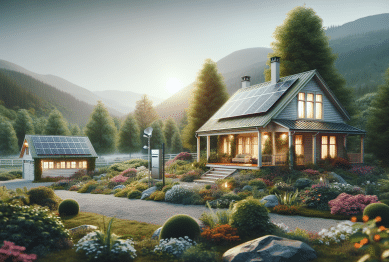Delve into the world of vertical gardens and discover how these innovative green walls can enhance home environments, maximize limited spaces, and support sustainable living. This guide shares creative ideas, setup tips, plant selection advice, and maintenance strategies to unlock the full potential of vertical gardening at home.
Why Vertical Gardens Are Gaining Popularity
Interest in vertical gardens is on the rise as more people explore ways to bring greenery into limited spaces. The surge of urban living has inspired inventive solutions, and vertical gardens stand out for their ability to turn blank walls into thriving plant displays. By utilizing vertical space, even small apartments or compact outdoor patios can enjoy the benefits of lush foliage without sacrificing precious square footage. Indoor vertical garden systems have become increasingly accessible, making it possible for more households to experiment with indoor plants and green walls for improved ambience and air quality.
People are drawn to vertical gardens for their ability to create a striking focal point. A living wall filled with ferns, succulents, or even edible herbs can add texture, color, and vibrancy to homes with limited gardening space. Apartment dwellers discover that they can enjoy foliage and fresh herbs without the need for a traditional yard or ground-level plot. In addition, these vertical installations have climate-adaptive capabilities, aiding in thermal regulation and energy efficiency within homes. The appeal isn’t just aesthetic—vertical gardens often become beloved features, inviting curiosity and admiration from visitors.
Adopting a vertical garden setup can align with eco-friendly goals, too. By choosing native or drought-resistant plants and using recycled materials for mounting, homeowners can reduce maintenance costs and support biodiversity. Incorporating a vertical garden can also inspire a sustainable lifestyle through composting and smart water usage. Many find that tending a wall garden promotes daily mindfulness and well-being. Together, these practical and emotional benefits position vertical gardening as a compelling trend within home and garden design communities (Source: https://www.epa.gov/green-infrastructure/what-green-infrastructure).
Designing a Vertical Garden That Fits Your Space
One of the top advantages of vertical gardens is their flexibility in design. Homeowners and renters alike can scale their green walls to fit any area—whether it’s a sunny kitchen nook or an unused stretch of outdoor fencing. There is no set formula. Instead, personal taste, plant needs, and space constraints shape each project. Start by assessing the location’s light exposure, humidity, and airflow, as these conditions will determine which plants will flourish. Modular panels, pocket planters, and trellis systems are all popular frameworks that provide structure while allowing air and water to circulate efficiently around roots and stems.
Consider how the vertical garden will integrate with your existing décor and daily routines. For some, the goal may be to grow a wall of herbs close to the kitchen, while others may envision a calming backdrop in the living area. Color themes, plant sizes, and growth habits play an important role. Mixing different textures—like trailing ivies, compact succulents, and delicate ferns—adds complexity and visual intrigue. Reclaimed materials such as pallets or repurposed wooden boards can lower costs, add rustic charm, and support eco-friendly gardening efforts. These creative touches make every green wall unique.
Watering and irrigation should be central to your design decisions. Some opt for self-watering systems or drip irrigation to ensure consistent moisture, especially when vertical gardens are installed indoors. Wall-mounted planters need reliable drainage to prevent root rot. Research plant compatibility—some species thrive together while others require individualized care. Placement is key: group moisture-loving plants at the bottom, where water accumulates, and drought-tolerant types near the top. With careful planning, even beginners can build a vibrant, low-maintenance display tailored to their space (Source: https://www.rhs.org.uk/advice/profile?pid=934).
Choosing Plants That Thrive in Vertical Gardens
When it comes to selecting plants for a vertical garden, successful choices depend on the wall’s light, water, and temperature conditions. For shaded interiors, ferns, pothos, and philodendrons provide lush greenery with minimal light. Succulents and small cacti adapt well to sun-drenched balconies or patios and require less frequent watering. Edible plants—such as herbs, lettuce, and strawberries—have become favorites for vertical kitchen gardens. These selections let residents harvest fresh produce directly from their living walls, adding dietary and sensory delight to indoor environments.
Mixing different species can help ensure year-round visual interest. By blending evergreens and perennials with annual flowers or trailing vines, you create a layered tapestry that evolves over the seasons. Research plant height, spread, and growth rates. Fast climbers like creeping fig or English ivy act as living wallpaper, quickly enveloping surfaces, while low-growing mosses and sedums provide texture and density. Some garden enthusiasts also introduce pollinator-friendly blooms to support local biodiversity and attract butterflies, bees, and birds to outdoor walls. These choices reflect a growing commitment to eco-friendly landscaping and wildlife habitats.
Soil choice matters, too. Lightweight potting mixes developed for vertical gardens allow roots to anchor securely while facilitating moisture retention and aeration. Some systems incorporate hydroponics or soilless mediums, which can reduce pests and maintenance needs. Before planting, check root compatibility, ensuring smaller-rooted species are positioned higher up, while those with stronger, spreading root systems occupy lower slots. Thoughtful arrangement lets each plant flourish, reducing crowding and encouraging a balanced, sustainable ecosystem (Source: https://extension.psu.edu/living-walls-and-vertical-gardens).
Vertical Garden Installation and Care Made Simple
Setting up a vertical garden might seem daunting at first, but with the right preparation, it’s accessible to gardeners of all skill levels. Always begin by gathering sturdy supports, moisture barriers, and reliable irrigation. Many modular systems come with easy-to-follow instructions, while DIY builds can be assembled with simple screws, anchors, and planters. Position the structure securely—especially for outdoor or large-scale walls—to prevent tipping or water damage. Select disease-resistant varieties to minimize future maintenance and optimize plant health.
Routine care is the key to vibrancy. Water requirements vary widely between species, but irrigation lines or periodic hand-watering keep roots moist. A soil probe or moisture meter helps gauge need. Seasonal fertilization with diluted organic feeds strengthens plants and improves flowering. Regular inspection ensures pests, mold, or signs of wilt are addressed before they spread. Prune trailing vines and remove unhealthy leaves for a tidy, uncluttered appearance. For interior installations, occasional dusting of leaves can improve photosynthesis and give the wall a fresh, polished look.
Many gardeners enjoy the weekly ritual of monitoring their green wall’s growth. Wall gardens often evolve, with plants needing occasional rotation or replacement. Higher humidity, especially in kitchens and bathrooms, may require dehumidifiers or fans for airflow. If cultivating edibles, wash hands before tending and avoid chemical sprays. Consider smartphone apps or journals to track watering and fertilization schedules. This thoughtful attention extends the life and beauty of your living wall, transforming it into a rewarding household focal point (Source: https://www.gardeners.com/how-to/vertical-gardening/8460.html).
Benefits of Vertical Gardens for Home and Environment
Vertical gardens offer more than just visual appeal—they improve air quality, increase privacy, and support climate resilience. Living walls filter pollutants from indoor and outdoor air, trapping dust and absorbing toxins. This can lead to a healthier living environment and may reduce respiratory complaints linked to poor air quality. Green walls used as privacy screens add a sense of enclosure without the bulk of traditional fencing, suitable for balconies or shared outdoor areas. Vertical gardens can also buffer noise, creating a quieter indoor or outdoor retreat.
Energy conservation is another strong argument for vertical gardens. In hot weather, plant-covered walls insulate homes, lower cooling costs, and reduce heat island effects common in cities. During colder months, they act as windbreaks and retain warmth. Some homeowners install vertical gardens along exterior facades to enhance insulation, prolong paint or cladding lifespan, and minimize the environmental footprint of building materials. These living systems align with broader sustainability goals, contributing to biodiversity and green infrastructure initiatives (Source: https://www.udel.edu/academics/colleges/canr/cooperative-extension/fact-sheets/vertical-gardens/).
Plants in vertical gardens provide soothing sensory benefits, reducing stress and boosting mood according to research. Tending to a living wall encourages daily observation and nature connection, which is shown to decrease anxiety and foster satisfaction. Many find renewed enjoyment in cooking with fresh-picked herbs or celebrating a flower’s bloom. With so many advantages, it’s easy to see why more homes are exploring the possibilities of vertical gardening as part of their interior and exterior design strategies.
Creative Ideas to Personalize Your Vertical Garden
There are countless ways to personalize a vertical garden, making it a true reflection of your style and needs. For culinary enthusiasts, mix aromatic herbs like basil, mint, and cilantro alongside edible flowers. A mix of succulents in geometric planters suits minimalist homes, while bursts of colorful annuals appeal to those who love changing with the seasons. Artists at heart experiment with patterns, shapes, and color gradients to turn green walls into living canvases.
DIY projects can repurpose unexpected materials: shoe organizers, rain gutters, or upcycled bottles transform into pocket planters. Consider adding integrated lighting for dramatic evening effects or mounting shelves for garden decor and tools. Some home gardeners blend vertical and horizontal planting—mixing wall-mounted displays with potted plants below for layered depth. This approach enhances the visual impact and offers additional habitat for small wildlife if the vertical garden is outdoors.
Families often involve children in the creative process, letting them choose plants or decorate containers. Sensory cushions, wind chimes, and nature-themed art add whimsical touches. Smart gardeners tweak plant selection seasonally, swapping in winter-hardy options or incorporating spring bulbs to ensure their green wall never looks tired. The key is adaptability; a living wall evolves and adapts just like the people who tend it (Source: https://www.bbg.org/gardening/article/vertical_gardening).
References
1. Environmental Protection Agency. (n.d.). What is Green Infrastructure? Retrieved from https://www.epa.gov/green-infrastructure/what-green-infrastructure
2. Royal Horticultural Society. (n.d.). Vertical gardening: living walls and green facades. Retrieved from https://www.rhs.org.uk/advice/profile?pid=934
3. Penn State Extension. (2021). Living Walls and Vertical Gardens. Retrieved from https://extension.psu.edu/living-walls-and-vertical-gardens
4. Gardener’s Supply Company. (n.d.). Vertical Gardening. Retrieved from https://www.gardeners.com/how-to/vertical-gardening/8460.html
5. University of Delaware Cooperative Extension. (n.d.). Vertical Gardens Fact Sheet. Retrieved from https://www.udel.edu/academics/colleges/canr/cooperative-extension/fact-sheets/vertical-gardens/
6. Brooklyn Botanic Garden. (n.d.). Vertical Gardening: A Living Wall for Every Space. Retrieved from https://www.bbg.org/gardening/article/vertical_gardening









